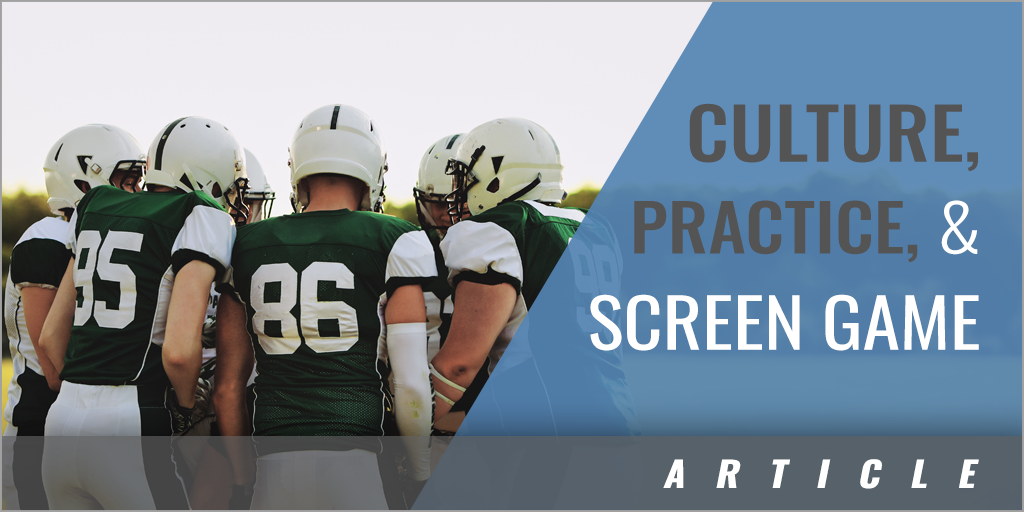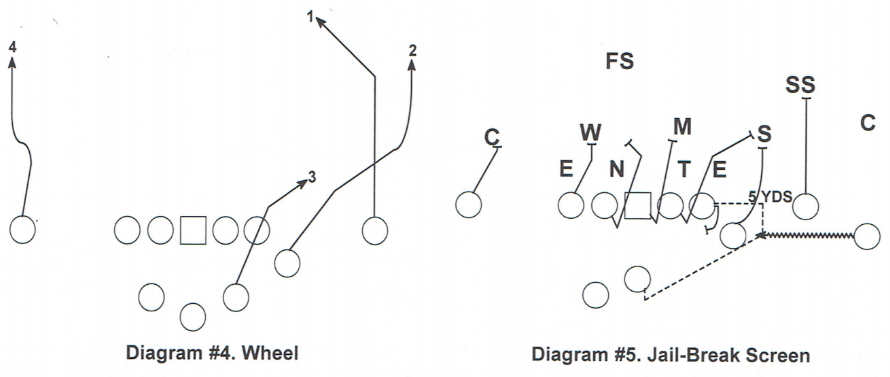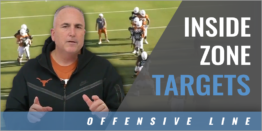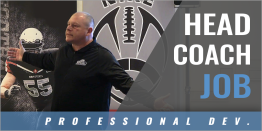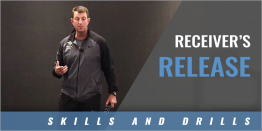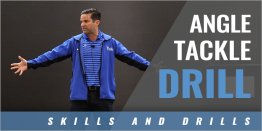|
By: Neal Brown - WVU Originally Published in: 2020 Nike Coach of the Year Clinic Manual - by Earl Browning Provided by: Nike Coach of the Year Thank you, it is good to be here in Pittsburgh. Before I get started, I want to introduce some of our coaches. This is Al Pogue, he coaches our outside linebackers and will be recruiting Pittsburgh and western Pennsylvania. Tyler Allen is our graduate assistant working with the quarterbacks. I want to give you some background information on me so you will have some insight into who I am. My father was a high school principal and before that he was a high school football coach. I was born in Bardstown, Kentucky. I lived there until my father took the principal job at Boyle County High School in central Kentucky. I went to high school in Boyle County, Kentucky and played football there. My father was the principal and later became the superintendent. My mother taught school. Both my grandmothers were school teachers. My entire life growing up was spent around a school. I was in a locker room or gym as far back as I can remember. With that being said, I have a ton of respect for what your coaches do daily. Coaching at the college level it is a little bit different. However, I still see my early up bringing in a lot of the things I do. l want this to be interactive so ask questions if you have them. I am going to start off with a couple of culture deals we do, which I think are good. Tonight. I am going to talk quite a bit about practice. I want to get into how we practice and what we do. I have some examples of things we did at Troy. which I liked. After that, I am going to get into some football stuff. I am an offensive coach. I played at the University of Kentucky as a receiver. I played there for three years and was fortunate to play for some great coaches. The head coach there was Hal Mumme. He was the architect of air raid offense. The wide receiver coach was Mike Leach. He is now the head coach at Washington State. Guy Morris was the offensive line coach and later was the head coach at Kentucky and Baylor. Tony Franklin was on that staff. Chris Hatcher was the quarterback GA. Now he is the head coach at Samford. Sonny Dykes was the tight ends coach. He is now the head coach at SMU. That was an offensive staff. After Coach Mumme left Kentucky, I transferred to Massachusetts Amherst for my senior year. I went to play for Mark Whipple, who is now the offensive coordinator at Pittsburgh. It is a small world in football coaching. I started my coaching career in 2003. as a GA at UMass working with the offensive line. I moved from there to Sacred Heart as the quarterback and wide receivers' coach. After a year, I went to the University of Delaware for a year. After that, I went to Troy as the wide receiver coach for two years and offensive coordinator for two years under Larry Blakeney. When he retired. he was the all-time winning coach by percentage in college football. I went to Texas Tech and was the offensive coordinator under Tommy Tuberville. I went to Kentucky as the offensive coordinator, and later back to Troy as the head coach. We were 31-8 over the last three seasons at Troy. We won the conference championship in 2017. We won three consecutive bowl games from 2016-2018. When you accomplish those things that means you are blessed with good players. We are in central Alabama around the Montgomery area. There are a bunch of good players in our geographic area. If you look at our record in close football games over the last three years. we are ranked close to the top in the country. We won a bunch of games by less than seven points. I want to talk about a couple of things that has been a difference maker for us. We give the players a one-page explanation of who we are as a program. At Troy, our mascot was a Trojan. In our culture statement, the symbol that went with Trojan was a "wall." When we came to West Virginia, the wall became a "mountain." This starts off with a belief system. There are some beliefs that really define us on the field. PROGRAM BELIEFS
Within the program. we have some core values that guide our team. Core Values:
Taking care of the ball is the turnover margin. We are passionate about winning the turnover margin. We back that up with a ball security circuit. We practice ball security daily in that circuit. Every day we practice we work ball security. Destiny favors the prepared means; preparation is tremendously important. I do not believe in good or bad luck. I believe you get what you earn over the long course of a game or the season. We preach this to our players. You must prepare your body. mind, and spirit to put yourself in a position to be successful. Has anyone seen the series called "All or Nothing?" It is on Amazon Prime. I thought Amazon was where my wife ordered stuff. She told me it was a cable network app. I watched a program called All or Nothing." It was about the Arizona Cardinals. Bruce Arians was giving a pre-game talk. He did not give a passionate speech. He said. "Just be Cardinals. Let's roll." That means this. You must beat us because we will not beat ourselves." In today's football, everyone is talking about finish. Everyone is talking about finishing a drill. I think that is important but if you look at the data. it is the team that starts fast that will win the game. At Troy, if we were ahead at the end of the first quarter. we were 21-2. In four years. we never lost a game if we were ahead going into the fourth quarter. Finishing is important, but in my opinion, getting out to a fast start is even bigger. That is something you want your players to believe in. The beliefs and core values are things we talk constantly. Environment to me is how you want to live. That comes from your beliefs and core value. That is the way we exist in our building and how we want to live. We want to be a program that has positive energy. Within the team, we want to have a family type relationship with each other. Today, the environment is totally different. We want our players to be around other players that have the same values and their relationships toward each other is important. We also want a competitive team and that is based on competition. Accountability is an important thing within our program. We do some things to reinforce that idea. Our players know exactly where they stand all the time. I think that is critical. We are in winter workouts right now. We are doing a ton of mat drills right now. We do them but I am not one of these guys that loves mat drills. There is a purpose for them. You get better and build discipline. When we work in the drills we have a rating system. We call it NOS and POS. NOS stands for "Not Our Standards." POS stands for "Positive. While we are working out we are doing these things. NOS includes mental error, lack of effort, and things of that nature. We watch the film of practice and score the players on their NOS or POS performances. We have a NOS tape that shows all the bad things. We have a POS tape that highlights all the good things that we do during the workout. We are setting the standard within the program. We are going to show them what is acceptable and what is not. This reinforces what we expect out of them during the winter and spring. I want to show you a practice schedule from last season. This schedule is from Wednesday of the second week. We played Florida A & M that week. When we set up the practice schedule, we divided it into meeting time, pre-practice. and actual practice time. Some of you guys have time for team meetings some of you do not. In our team meeting, we start out in position group meetings. We walk through what we are going to do during that time. We come back together as a team and go over special teams. In our pre-practice, we work on quarterback/ center exchanges. After that, we do a couple of drills with the quarterbacks, receivers. and tight ends working together. Those drills are heavy on fundamentals. We come together for a specialty period that lasts for five minutes. We have a different point of emphasis every day. On this practice schedule. the point of emphasis was kickoff return. We have three kickers and we work on all situations that could happen on the kickoff. We squib kick, sky kick, plus an onside kick. That is in addition to normal returns. During our special teams period, we always work on the punt return, kickoff return, and snappers. We work them every day. From there we go to a team stretch period. We do this more for comradery then stretching. We have already warmed up during pre-practice. We do this to come together as a team. The coaches circulate and have conversations with the team. It is a team-building exercise. We start each practice with some kind of competition. On this day we did a cage drill. That is similar to a board drill. We go offense versus defense. These are a serious drill with a lot at stake for the offense and defense. These are pride in building exercises. The first period of practice is always a kickoff return or kickoff. We work the kickoff on Tuesday and the kickoff return on Wednesday. Why do we do that? That is the way you start a game. You have a kickoff and a kickoff return. If you want to get the practice off to a good start, do something that is a game like. We are good at scoring on the first drive and leading at the end of the first quarter. The next period is team offense versus second-team defense. We work first offense versus first defense and then seconds versus seconds. We have a drill period. I am going to go through some of this drill later. After the drills, we have a break. When we come back from the break, we have another special team's period. The break is to assimilate halftime. However, it is only five minutes long. After halftime in a game, you come back with kickoff and kickoff return. We are trying to assimilate a game practice-wise. This drill is called "spar drill." This title is We revised the drill. The offense starts out with a drive starter play. Followed by two fastball plays going as fast as they can. After those plays, the first defense goes off the field and the second defense comes on. As soon as they are set, the offense snaps the ball and runs plays 4, 5, and 6 as fast as they can. On the next set of downs. the second offense comes on the field and the first defense comes back. The second offense runs a drive starter and the second and third plays as fast as they can. We get 9 plays in about three minutes. That includes changing the teams. On Sunday morning when I get up I want to see who played well versus a three-down front and who played well versus a four-down front. I am a thief for plays. In the first game of the season, Maryland beat Texas. Texas is a three-down team. We played Nebraska this year and they were a three-down team. Maryland ran this play against Texas. I copied it and ran it against Nebraska and we scored the winning touchdown on it. The spar drill is a good drill. You get the work in a short period of time. It is good to work for the offense and for the defense as well. If you want to get good at something you have to practice it. This is the tackle/wrap drill. In 2015 we were pretty good at this. I will not say we were great but we were pretty good. We had some kids that played hard and we won 4 games that year. We were 4-8. The following year we won 10 games. That was a six-game improvement and the kids were all in. The problem we were having is we were not making people miss tackles. We were good at catching the ball but not very good after the catch. We had to go back and look at the situation and see what we can do as a coach to improve the problem. I was thinking about making people miss or us not running through tackles. When you go back and self-evaluate you come up with practice. You cannot expect them to make people miss the tackle if you are not practicing it. We were not practicing how to break tackles or get yards after the catch. It worked on both sides of the bail. If you are missing open field tackles on defense, it can lead to big plays. If you are doing that on defense. it is because you are not practicing it enough. In spring practice and fall camp any day we were in full gear up to the start of games we worked the tackle and wrap drill." We worked good¬on-good with the offense versus the defense. It made quite a difference for us with our receivers and running backs setting up blocks and making yards after catching the football. And we got way better at making open field tackles on defense. We are a fast screen team. In the drill. we want to assimilate catching the fast screen against a secondary scheme. (Diagram #1) It could be quartered, cover-2, or something like that. We run the drill with a defensive back and receiver. They align in their positions. On the command. they hit the ground and get up. They run full speed trying to get to the sideline. The tackler wants to pen the receiver into the sidelines and make the tackle. The receiver wants to evade the tackle.
The receiver does not want to make a move to far from the tackler. He wants to make up the space between him and the tackler. When he makes his move he wants to skinny up the sideline. If he cannot reach the sideline, he runs through the inside shoulder of the tackler. That puts the tackler at a disadvantaged position on the receiver. The tackler ends up with an arm tackle attempt. We attack the weak shoulder and get back inside on the tackler. When we work this drill. we pair up the receivers and defenders. The inside receivers and tight ends go against the safeties. Our outside receivers go against the corners. The running back is going against our outside linebackers. That is how we divide up the groups, We do three stations and rotate around. We try to get everyone two reps at each station. There is a difference between a good offense and bad defense. From a practice standpoint, this has been really good for us. This is good for the offense and the defense. There are four things we are going to sell our team on. It is the basis for our practices.
It is critical and that is what you are going to sell your team. Those things have to be in the practice plan. Every day we do some kind of red zone drills. We have a ball security/take away circuit. We have four offensive coaches to run the ball security drills. Each coach has about five drills and they rotate throughout those drills. The focus of each drill is ball security. Make sure when you set up the circuit, they are in close proximity to each other. At the same time. the defense is working through their circuit but the focus is on taking the ball away from the opponent. They are working in three stations. The drills are pretty basic. In one station we are working different cuts. We work 45-degree and 90-degree cuts. When we do the cuts we want to make sure the ball stays tight and secure. We also work the weak shoulder cut. We work under the chute to teach pad level with the ball kept tight and secure. We get the circuit down in 4 minutes. We have a bunch of balls in the drills. We also use water balls to make the ball slippery. At Troy last year we were rolling offensively. We had a new quarterback and lost badly to Boise State in the first game. However, in games 2-6 we were rolling. We are playing as good offensively as anyone in the country. We played Georgia State on Thursday night. In the first quarter. the quarterback had 100 yards rushing and 200 yards passing. He was unbelievable. The score was 28-0. He came to the sideline in the second quarter and told me he hurt his knee. I sent him to the trainer. Two minutes later the trainer comes up to me and told me he tore the ACL. This was a bad deal halfway through the year. We went on to win 10 games but we were an entirely different team. The kid we brought in to replace him did some things well. He could throw the deep ball well but he struggled accuracy wise at the immediate area. We had to go back and find some things that he could do. One thing we did was to invent some things he could do. We call this play "fox." This play is a perfect example of football being overcomplicated by leaps and bounds. There was some good reasoning behind this play. We were running the plays with zone principles. We had three backs. We were running a split zone, option. and zone option. We lined up in a bunch of full houses backfield stuff. When you do that you end up in with a 9-man defensive box. On our team, we have a receiver that is going to be in the NFL. His name is Damion Willis. He is 6-4 and 200 pounds. (Diagram #2) We told the quarterback to get in the shotgun, take a five-step drop, and throw the ball to number 15. He threw it to number 15 every play. We told him the only time he did not throw him the ball was if they put two defenders under him. If they played two over one on number 15, he threw the ball as far as he could to the receiver on the other side.
What we did in the backfield did not make any difference. all we needed was a one-on-one look to Damion. The quarterback was not very good at play action. He understood how to throw the go ball. There are two places the quarterback cannot miss. He cannot overthrow the ball or throw it out of bounds. Everywhere else is fair game. The week following the Georgia State game. we tried to throw the four vertical game and the week following that game we went to a play action scheme. None of that worked too well. We went back to throwing the ball to him anytime he got a one-on-one look. People would play him in quarter coverage. The corner would play 10 yards off him. They assumed if they were that deep we would not run the go route with him. The corner is not used to playing the go route when he is in off coverage. If the defense was a cover-3 type defense, the quarterback took a five-step drop. That gave the receiver time to get to the corner back's toes. If the coverage was tighter, the quarterback took a three-step drop. This next play comes off a play action pass or screen action pass. (Diagram #3) The Z-receiver is aligned to the field. His alignment is on the numbers. The boundary receiver is a plus 2-yard alignment outside the numbers. The Z-receiver is running a post cut to the center of the field. The boundary receiver runs at the corner until he can get so close. he steps on his toes. He wants the corner to put his hands on him. When he puts the hands on the receiver, he sticks his foot in the ground and comes back three steps to the quarterback.
The quarterback wants to throw the ball high and let the receiver go get it. We also run the pattern with a wheel route. (Diagram #4) Our wheel is a little different from most people's wheel. We are running more of an out and up pattern. The receiver's landmark and the aiming point are the numbers. If the wheel route is noncovered with no one Over him. he continues up the field. This pattern is like a wide go route. If he is covered at 10 yards he kicks out of this route, puts the breaks on. and turns back to the quarterback.
The back to that side runs a check down into the flat. The quarterback reads the post. wheel. and flat. In this offense, we do not have a fullback. With the two remaining backs in the backfield, they are both running backs. With this offense, we ran the split back zone play or the screen off that. We ran the split zone and read the defensive tackle. If he stayed outside we handed the ball off. If he came inside we threw the screen. We did the same thing reading the overhang player. For the quarterback, there is a lot to learn. We teach him all winter, through spring ball, and into fall camp. What he sees is not going to change. It is what it is. What we try to do is give the defense different looks and do the same thing. We run a screen, which is the staple of what we do. Essentially this is a jail-break screen. We are going to throw the screen to the Z-receiver. His split is called "reduce the line." That means his split is two yards inside the numbers. (Diagram #5) If he is into the boundary, he splits the difference between the numbers and hash mark. If he is to the field. he takes a hard jab and comes straight down the line of scrimmage at three-quarters speed. He wants to catch the ball four to five yards outside the tackle. The key block is the Y-tight end on the Sam linebacker. He is going to release up to two steps and block the Sam linebacker. He is not going to kick out a defender unless he is inside five yards. We slide the line protection to the screen side. The play side tackle is going to high/low block the defensive end and try to cut him down. The play side guard holds his contact for one count and releases to the tight end. They will double team the Sam linebacker. The center sets for one count and has the first linebacker in the box. The backside guard sets for one count and blocks the second linebacker in the box. The backside tackle sets on the defensive end and high/low him. If the Will linebacker follows the running back, the backside guard and center double the first linebacker in the box. The quarterback takes an open step to the screen side. He shuffles and flips the ball to the Z-receiver coming down in motion. It is not a pass as to the definition of a pass. It is more of an overhanded toss. He has to be accurate with the throw. We are not going to block the corner unless he gets inside the five-yard area. He is the worst tackler on the defense and we will take our chance with him. When you throw this screen. throw it to the receiver that has the most courage. Speed does not matter on this screen. The player we threw this screen to was the second leading receiver for the last three years. We only ran this screen to the right because that receiver had the most courage. We did not throw the screen to the left because the receiver on that side did not understand courage. He only ran 4.75, but he ran 4.75 every time. That is how he hit the screen. The thing that hurts this play is a press coverage by the defensive backs. If the Z-receiver has a press technique aligned on him, he has to create space to catch the ball. If the number-2 receiver to that side has press coverage, he has to do the same thing. I appreciate you coming. I will be around for a while if you have any questions. Come see us at West Virginia. |
